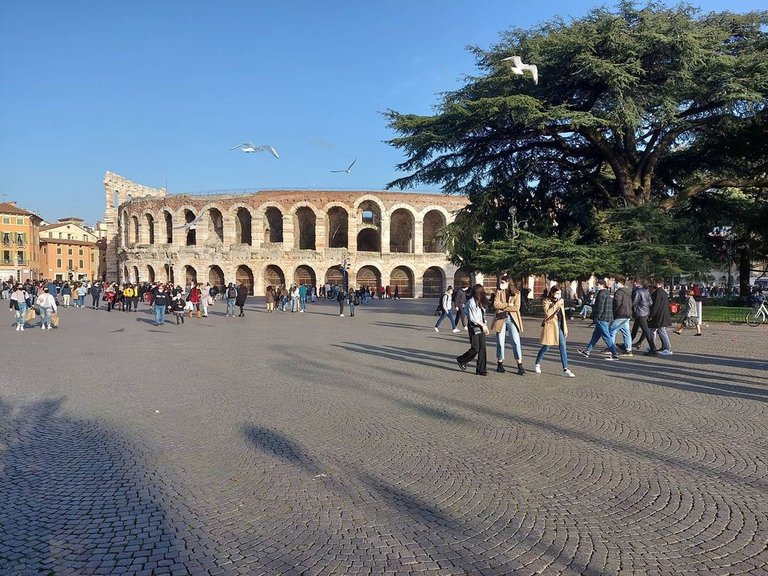
Verona è Indubbiamente la seconda città italiana dopo Roma per la presenza di resti Romani così ben conservati. Colonia romana già dal primo secolo A.C., Verona divenne municipium Romano nell'anno 49 a.c. il viaggio nel tempo inizia con l'Arena che è il simbolo di Verona, edificata nella prima metà del primo secolo D.C., è diventata nel tempo sinonimo di arte e spettacolo: dall'inizio del Novecento ospita il festival areniano, un cartellone di opere liriche di alto livello per l'accuratezza delle esecuzioni e la grandiosità degli allestimenti scenici, favorito dall'ottima acustica dell'Anfiteatro. La struttura muraria dell'Arena è costruita con predominante impiego della pietra della Valpolicella . La parte più alta, la cosiddetta Ala , e ciò che rimane dell'anello esterno alto Ben 30 metri. Si conserva intera la seconda cinta a due ordini di 72 Arcate. Al suo interno, dalla platea s'innalza la gradinata o cavea di 44 gradini, accessibili da 64 vomitoria. L'anfiteatro romano può ospitare fino a 22000 persone.
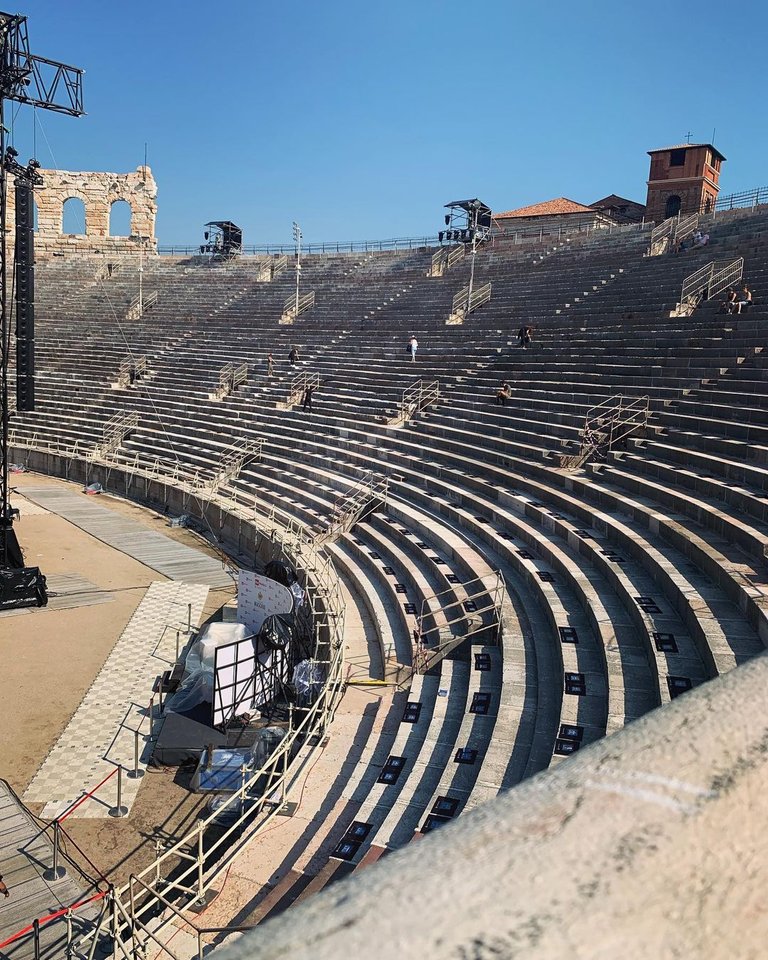
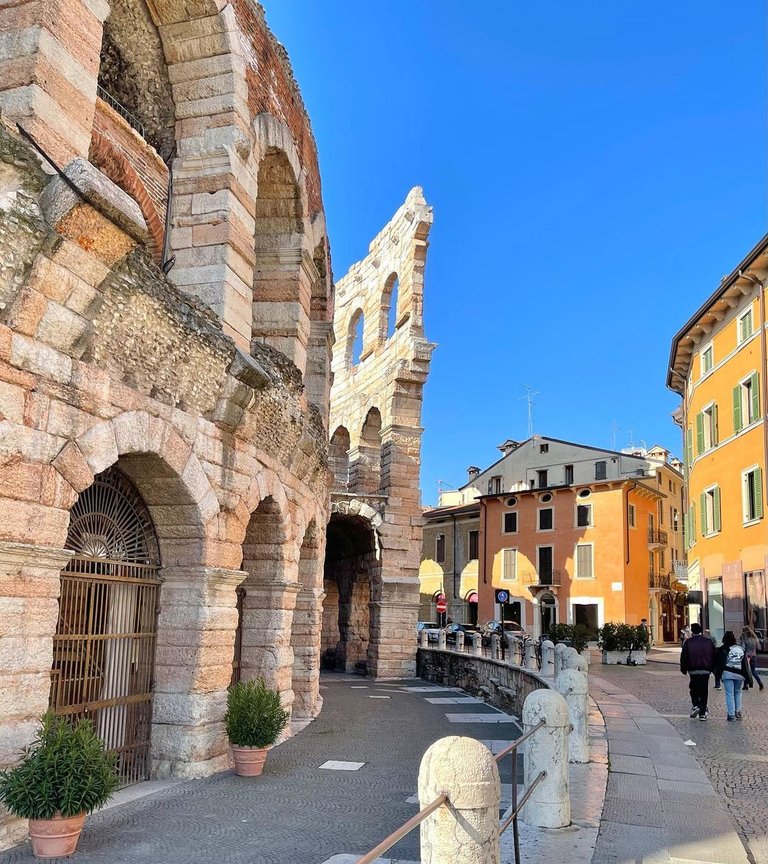
Verona is undoubtedly the second Italian city after Rome for the presence of Roman remains so well preserved. A Roman colony as early as the first century BC, Verona became a Roman municipium in the year 49 BC. the journey through time begins with the Arena which is the symbol of Verona, built in the first half of the first century AD, over time it has become synonymous with art and entertainment: from the beginning of the twentieth century it hosts the Areniano festival, a program of operas of high level for the accuracy of the executions and the grandeur of the staging, favored by the excellent acoustics of the Amphitheater. The wall structure of the Arena is built with the predominant use of Valpolicella stone. The highest part, the so-called Ala, and what remains of the 30 meter high outer ring. The second two-tier enclosure of 72 arches is preserved. Inside, the staircase or cavea of 44 steps rises from the stalls, accessible from 64 vomitoria. The Roman amphitheater can accommodate up to 22,000 people.
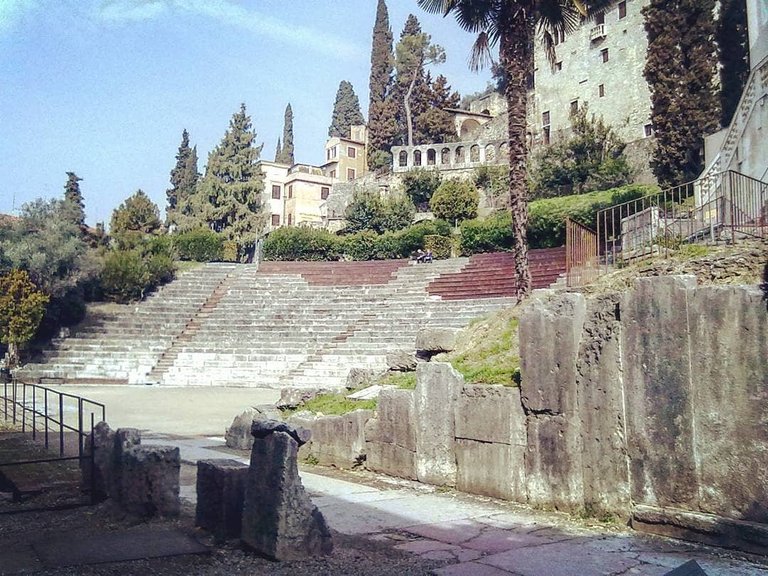
Il teatro romano costruito verso la fine del I secolo a.c. è situato sulle pendici del Colle San Pietro, di fronte al centro urbano Romano al di là del fiume Adige. Oggi Rimangono delle teatro originario solo la cavea e la gradinata, oltre ad alcune Arcate di logge e i significativi Resti della scena . Da giugno a settembre il teatro romano ospita l' Estate teatrale Veronese, una rassegna di musica, danza e teatro, all'interno della quale riscuote grande successo di pubblico il festival shakespeariano . Se si attraversa la platea e si sale la scaletta occidentale si giunge all' ex convento di San Girolamo che dal 1924 ospita il museo archeologico.
The Roman theater built towards the end of the 1st century BC. it is located on the slopes of Colle San Pietro, in front of the Roman urban center on the other side of the Adige river. Today only the cavea and the steps remain of the original theater, as well as some arcades of loggias and the significant remains of the scene. From June to September the Roman theater hosts the Veronese theatrical summer, a review of music, dance and theater, in which the Shakespearean festival is a great success. If you cross the stalls and climb the western ladder you reach the former convent of San Girolamo which has housed the archaeological museum since 1924.

Con l'affermarsi della Signoria Scaligera Verona vive una fase di complessiva riprogettazione. In questo periodo i palazzi del potere politico ed economico trovano la loro sede in Piazza Erbe e Piazza dei Signori con Gli annessi cortili del Mercato Vecchio e del tribunale. Nel 1354 Cangrande II della Scala Fa erigere Castelvecchio, imponente edificio militare del Medioevo Veronese a difesa di possibili rivolte da parte degli abitanti della città. La Fortezza viene costruita sulle sponde del fiume Adige e il suo ponte, Il ponte Scaligero, garantisce la via di fuga da Verona. Nel corso dei secoli Castelvecchio è stato utilizzato per molteplici scopi, come deposito d'armi, Accademia Militare e caserma. A partire dal 1925 diventa sede del museo di Castelvecchio. L'importante restauro del 1957 ad opera dell'architetto Carlo scarpa struttura il museo nella forma attuale con 29 sale di opere d'arte che vanno dal romanico Padano al 700 Veneto, sotto forma di sculture, miniature, oreficeria, rilievi ed epigrafi, armi, ma soprattutto dipinti della scuola Veronese e di altre scuole italiane e straniere e la statua equestre originale di Cangrande I.
With the affirmation of the Scaligera Lordship, Verona is experiencing a phase of overall redesign. In this period the palaces of political and economic power find their headquarters in Piazza Erbe and Piazza dei Signori with the adjoining courtyards of the Old Market and the court. In 1354 Cangrande II della Scala had Castelvecchio built, an imposing military building from the Veronese Middle Ages to defend against possible revolts by the inhabitants of the city. The fortress was built on the banks of the Adige river and its bridge, the Scaligero bridge, guarantees the escape route from Verona. Over the centuries Castelvecchio has been used for multiple purposes, such as a weapons depot, Military Academy and barracks. From 1925 it became the seat of the Castelvecchio museum. The important restoration of 1957 by the architect Carlo Scarpa structures the museum in its current form with 29 rooms of works of art ranging from the Romanesque Padano to 700 Veneto, in the form of sculptures, miniatures, jewelery, reliefs and epigraphs, weapons , but above all paintings of the Veronese school and other Italian and foreign schools and the original equestrian statue of Cangrande I.
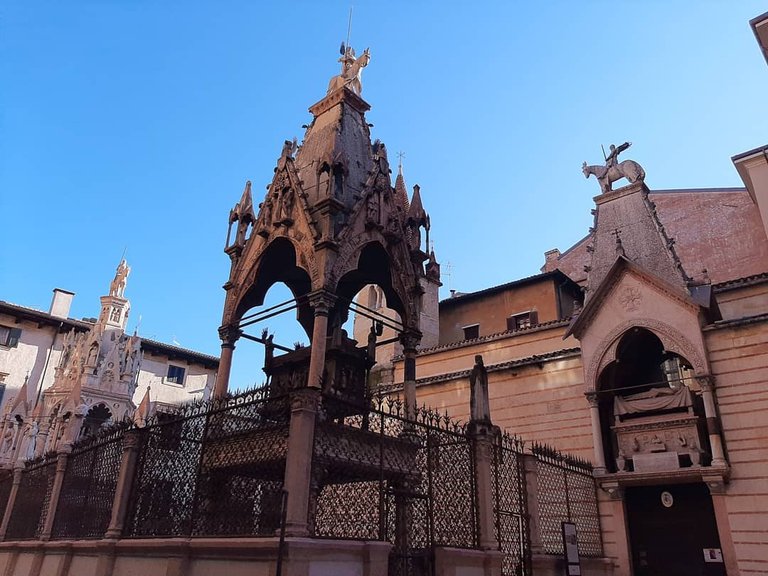
Le Arche scaligere sono uno dei monumenti più rappresentativi della Verona medievale, tracce indelebili della grandezza della Signoria della Scala nell'impianto urbanistico della città e nella memoria dei sudditi e dei posteri. Le tombe sono raccolte all'interno di un cortile circondato da un recinto di ferro battuto, con stemmi della famiglia della Scala . Le 3 tombe a baldacchino sormontate dalla statua equestre del defunto sono di Cangrande I, Mastino II, e Cansignorio della Scala
The Scaliger Arches are one of the most representative monuments of medieval Verona, indelible traces of the grandeur of the Lordship of the Scala in the urban layout of the city and in the memory of subjects and posterity. The tombs are gathered in a courtyard surrounded by a wrought iron fence, with the crests of the della Scala family. The 3 canopy tombs surmounted by the equestrian statue of the deceased are of Cangrande I, Mastino II, and Cansignorio della Scala
@tipu curate 2
Upvoted 👌 (Mana: 84/112) Liquid rewards.
troppo bella Verona!!